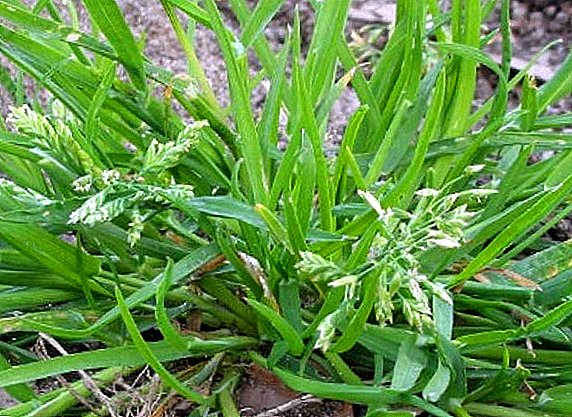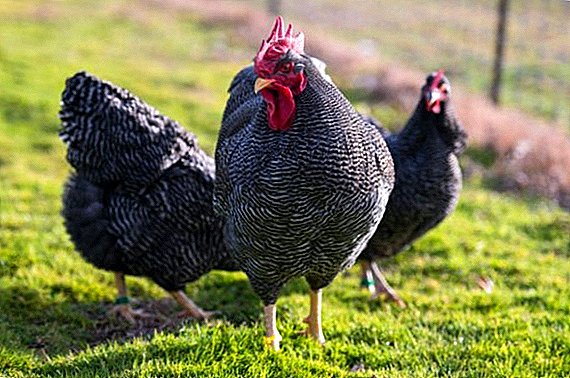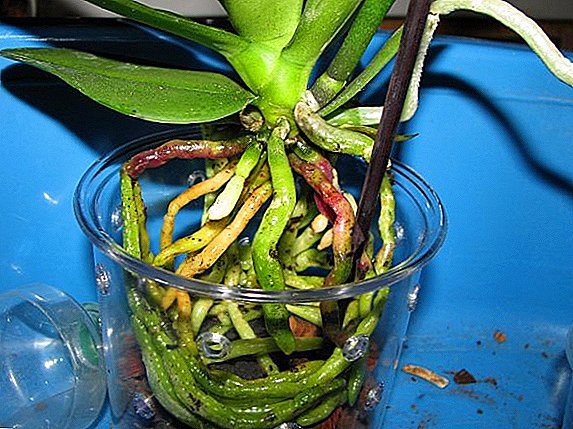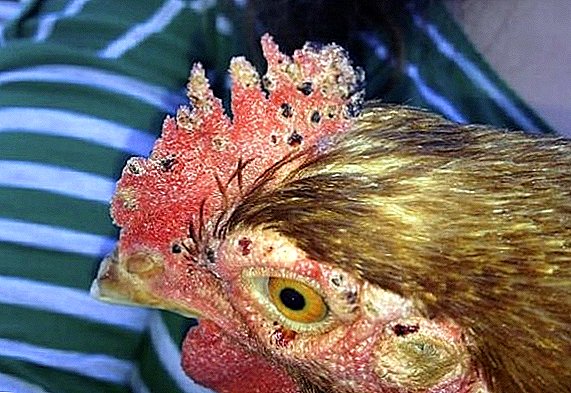 Dermanyssus gallinae, or chicken tick, has a huge range. It can be said without exaggeration that they embrace the whole world. The name does not mean that it parasitizes only on chickens.
Dermanyssus gallinae, or chicken tick, has a huge range. It can be said without exaggeration that they embrace the whole world. The name does not mean that it parasitizes only on chickens.
The owner of the tick can be wild birds, various mammals, including humans. About how dangerous the parasite and how to recognize it - in our article today.
What are dangerous ticks for chickens?
Chicken mite - the scourge of many poultry farms and farms, therefore, the owners of chicken herds, this parasite is familiar firsthand. The little red bloodsucker does not only cause inconvenience to the bird, but also is a carrier of many serious diseases: plague, cholera, borreliosis, etc. With its appearance, the youngsters begin to fall, and in adult birds their productivity decreases.
The parasite appears in a damp, poorly ventilated house. It is mainly wound up in bedding, sometimes lives in nests and can infect newborn chickens, because of which they slow down in growth and development, often die. One of the signs of the presence of parasites is that the hens begin to eat more, and the eggs are less. Also, chickens may pale combs and earrings because of the large blood loss. If time does not detect trouble, the birds die.
We recommend to learn how to make ventilation in the house with your own hands.

What kind of tick can a chicken have?
The feathered inhabitants of poultry houses are found various ticks, from very small, which can not be seen without a microscope, to a wave of obvious and recognizable to the naked eye. Micro parasites live on the skin constantly, feeding on keratinized skin cells and skin secretions. Large ticks need the blood of birds for food, and they live and breed in the poultry house.
Poultry owners often face the problem of worms in chickens. To combat these parasites use the drug Alben. "
Microscopic
- Knemidokoptes - parasites that provoke scabies of the body and legs in birds.
- Epidermoptes - the causative agent of skin scabies.
- Cytodites is a tick parasitizing in the respiratory system (mainly in the lungs).
Larger
- Ixodic tick (bloodsucker, affecting both animals and people).
- Persian tick (parasite prefers to live exclusively on birds).
- Red chicken tick (causes death of young animals, and also reduces the egg production of laying hens).
 Chicken mite
Chicken mite
What diseases cause: how to remove and how to treat
Parasites visible to the naked eye, and those that cannot be seen without a microscope, are not only an annoying factor in the life of birds, but also carriers of a large number of infectious diseases. In addition, the itchiness that accompanies most of the parasitic effects provokes the bird to constantly tear apart problem areas, which leads to wounds of new infections.
Learn how to rid chickens of parasites such as peroed and lice.
Foot scab
Knemidokoptoz, which received its name from the microscopic parasite-pathogen Knemidocoptosis, is popularly known as foot scabies. Another apt name is “limy foot”, which originated from the appearance of the affected leg: swollen, knotted scales of legs, covered with growths in a neglected form.
The disease is slow, turning into a chronic condition. Chickens aged 3 to 5 months are particularly susceptible to it. The danger of this parasitic infection is that it is possible to notice external manifestations only after several months. Prior to this, the tick itself does not detect, and only after the accumulation of exudate there are signs of inflammation.  Breeds of birds whose legs are covered with feathers are less likely to be attacked by a tick. In other breeds, when the legs and beak are affected, there appear bumps resembling a fine lime (hence the name). If such a bump is picked up, then you can see the moves that the parasite has bitten: the internal structure will look like a sponge. The disease can last for years, subsiding by the winter and again activating with the arrival of spring. As a result of neglected conditions, the toes or feet completely die off.
Breeds of birds whose legs are covered with feathers are less likely to be attacked by a tick. In other breeds, when the legs and beak are affected, there appear bumps resembling a fine lime (hence the name). If such a bump is picked up, then you can see the moves that the parasite has bitten: the internal structure will look like a sponge. The disease can last for years, subsiding by the winter and again activating with the arrival of spring. As a result of neglected conditions, the toes or feet completely die off.
Did you know? The first homemade chicken is from Ethiopia. Thus, the history of home breeding of this bird has been around for about three thousand years!The treatment consists in applying to the affected areas of acaricidal preparations:
- bath of forty-degree birch tar: the hens' feet are dipped into it by the hock; 300 g of tar will be enough for a dozen of birds;
- Nicochlorane half-percentage emulsion;
- birch tar in half with kerosene;
- azuntola emulsion 0.3%;
- 1% solution of trichlormetaphos.
Telny scab
The causative agent of knemidocoptosis of the body is the same as in the previous case. This tick differs from its counterpart only in light yellow. It lives mainly in feather bags, in the folds of the skin of the chicken, forming knots in the skin. In the nodes it contains its progeny.
The disease is seasonal, occurs in spring and summer. The skin of the bird becomes red in the places of defeat, loses its plumage, flakes off. While experiencing severe itching, the chicken tries to peck out the parasites, than it hurts its skin even more.  Treatment consists in bathing sick birds in special solutions:
Treatment consists in bathing sick birds in special solutions:
- Yakutin;
- Neguvon;
- "Mikotectan";
- chlorophos aqueous solution 0.4%;
- azuntol 0.2%.
Important! If a large part of the chicken’s body is affected, only a third of the skin can be lubricated at a time.
Scabies
Other name - epidermoptosis. The causative agent is a yellowish micromite of the epidermoptes, settling in the feather follicles, under the upper dermal layer.
The probability of infection increases many times during the warm season. Foci of disease can be seen first on the poultry chest, then on the neck, and later the disease spreads to the head, touching the comb and earrings. If you start the treatment, the spread will go further, on the back and on the upper part of the legs. Peeling, red skin with crusts of dried ichor - this is the main sign of epidermoptosis. The skin in particularly sensitive areas is so inflamed that it can die off, emitting the smell of rot. Most often itching is not observed.
Effective treatment will be the treatment of inflamed areas of the skin with ointments or acaricidal solutions:
- tar ointment in a ratio of 1: 5;
- creolin ointment, 1:10;
- solution of tar in half with alcohol;
- K emulsion of soap (5%).
 If the whole chicken herd or most of it has strong lesions, you can spray the livestock with a half-percent solution of chlorophos.
If the whole chicken herd or most of it has strong lesions, you can spray the livestock with a half-percent solution of chlorophos.
Important! Modern science has debunked the myth that ticks are dangerous only in late spring and early summer, and you can’t forget about them the rest of the time. Chicken mite is active 6 months a year, therefore inspections of the house should be carried out regularly.
Red chicken tick
The causative agent from the Gamazov family has a yellow color until it is saturated with blood. The size of the "hungry" tick is 0.7 cm, having stuck, it can double in size. These parasites usually do not live on their victims, but nest in the house. The period of their daily activity falls at night, sometimes during the day they hide in the skin folds of chickens.
The red chicken tick is resistant to low temperatures, it can starve for a whole year, and even its larvae suck blood. It is extremely dangerous because it is a carrier of many infectious diseases, including those common to chickens and to humans.
VIDEO: RED CHICKEN TICKLE IN HENS Symptoms include itching and inflammation of the affected area in the part in which the tick has got: larynx, trachea, nose, ear canal. Chickens massively die from exhaustion and blood loss. Chickens practically lose egg production.
Did you know? Chickens do not distinguish their eggs from strangers, and if a bird subtly replaces eggs, then it will sit them out as its own.
The treatment will be the treatment of sick birds dust sevina (at a concentration of 7.5%). Depending on the severity of the lesion, one chicken leaves from 5 to 15 g of dust.
Persian tick
The parasite of the Argass family, has the greatest distribution in the southern regions. It leads to exhaustion and death of an infected bird, is a carrier of many infections, including salmonellosis and tuberculosis. Dangerous for birds and for humans.
Persian mite has a large size, 10 mm by 6 mm. Active shows at night, the rest of the time prefers to hide in the nooks of the house. Both adult and larvae feed on blood. During a bite, saliva enters the body of the chicken, which negatively affects its nervous system - paralysis can develop. Bite sites become inflamed, body temperature rises. Many chickens die from the Persian tick; adult chickens respond to the parasite by reducing their weight and egg production.
It is useful to know how to increase egg production in chickens in the winter and what vitamins are needed for laying hens so that they are well born.
The treatment consists of treating with 7.5% dust, as in the situation with the red tick. 
Cavity tick
He is also a cytodiasis, he is a pulmonary tick. The causative agent - cytodites, settling in the lungs or bronchi of the bird. This is an extremely dangerous disease, sometimes mortality is up to half of sick chickens.
It is difficult for the bird to breathe, it pulls out the neck and throws back its head in an attempt to get more air. From the nose appear mucous discharge gray. If during this period to put pressure on the trachea, the chicken goes into a cough. Affected individuals not only lose their appetite and weight, but can also fall into a state of coma.
Although some measures to rescue sick birds are being undertaken (for example, the introduction of camphor oil into the abdominal cavity), treatment is considered ineffective and there is little hope of recovery. Sick birds are slaughtered, the remaining are disinfected by spraying acaricides. The best option would be to replace a sick herd with a healthy one.
Important! Be sure to conduct a thorough disinfection of the house before running new chickens there!
Ixodic tick
This parasite is not so dangerous, but it can parasitize both on chickens and people. Usually, after drinking blood, the female tick itself disappears. Therefore, no therapeutic measures are required if you suddenly find an ixodic tick on a bird. Just take it off with tweezers.
Are chicken ticks dangerous to humans?
The main harm for a person from chicken mite is, of course, financial loss. Affected birds that die, disinfecting the poultry house, reducing the productivity of the remaining individuals - all this severely hits the poultry baker's wallet, given that the tick first of all affects the young and the hens.  Infected chickens are itchy and constantly itch. In the European Union, statistics are kept even on such issues: the loss of chicken mites from poultry farms sometimes amounts to about 130 million euros a year.
Infected chickens are itchy and constantly itch. In the European Union, statistics are kept even on such issues: the loss of chicken mites from poultry farms sometimes amounts to about 130 million euros a year.
Did you know? Chickens are not as stupid as is commonly believed. For example, a chicken is able to recognize its owner and, having spotted him for another 10 meters, he runs to meet.But there is another danger: in the hungry period, when there are no large numbers of birds or other "owners" nearby, the tick actively attacks a person. At the site of bites, itchy rashes occur, accompanied by severe scabies. On the infectious danger of such bites, scientists have not yet come to a common opinion, but there is no official confirmation yet.
Prevention
The following measures can be attributed to preventive measures as well as to first-aid measures:
- regular inspection of the house (you can take a clean sheet of paper and walk with it through all the cracks and cracks - if there are parasites, a lot of small dots of dark gray color will fall on the sheet);
- housekeeping (if the slightest threat is detected);
- complete replacement of bedding, processing of drinkers and feeders.
Parasitic diseases are dangerous for both humans and their pets. Therefore, it is important to take all measures depending on you in order to maximally protect your birds from tick attacks. Do not forget about the prevention and regular inspections of the house, and your flock will be healthy and productive.
Video: How to get rid of chicken mite in the chicken coop
Methods of dealing with chicken mite from netizens















